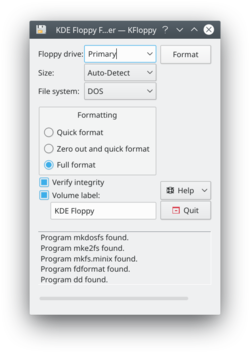KFloppy: Difference between revisions
Appearance
No edit summary |
m Make the structure more handful for translation |
||
| Line 16: | Line 16: | ||
<!--T:4--> | <!--T:4--> | ||
{{Note|A floppy cannot be formatted if it is mounted.}} | {{Note|A floppy cannot be formatted if it is mounted.}} | ||
* Select the floppy drive which contains the media to be formatted | * Select the floppy drive which contains the media to be formatted | ||
* Select the size of the floppy to be used. In most cases it is safe to leave this as "Auto-Detect", and should be changed only when encountering size related issues during formatting | * Select the size of the floppy to be used. In most cases it is safe to leave this as "Auto-Detect", and should be changed only when encountering size related issues during formatting | ||
* Select a filesystem to be used | * Select a filesystem to be used | ||
** If the desired filesystem is not listed, check the box at the bottom of the window, it may provide a reason | ** If the desired filesystem is not listed, check the box at the bottom of the window, it may provide a reason | ||
** Not all supported filesystems are usable on floppy disks | ** Not all supported filesystems are usable on floppy disks | ||
* Select the type of format to perform | * Select the type of format to perform | ||
** Quick Format is as the name implies, the fastest process. It does check for bad blocks or other errors | ** Quick Format is as the name implies, the fastest process. It does check for bad blocks or other errors | ||
** Zero out and quick format will overwrite each sector with zeroes. This should not be relied on for securely erasing a disk, only a quick method of destroying data | ** Zero out and quick format will overwrite each sector with zeroes. This should not be relied on for securely erasing a disk, only a quick method of destroying data | ||
** Full format will format the media, and check for bad blocks and other filesystem defects if possible | ** Full format will format the media, and check for bad blocks and other filesystem defects if possible | ||
* Check '''Verify Integrity''' if KFloppy is to check if the format was successful | * Check '''Verify Integrity''' if KFloppy is to check if the format was successful | ||
* Provide a name for the floppy, if desired | * Provide a name for the floppy, if desired | ||
* Click '''Format''' to format the media | * Click '''Format''' to format the media | ||
Revision as of 06:41, 26 December 2018
A Graphical Tool for formatting floppy disks

Features
- Quick or full format
- Bad sector checking (via Verify Integrity)
- Can label disk
- Supports command line options
- Supports DOS, ext2, UFS and Minix file systems
Usage
- Select the floppy drive which contains the media to be formatted
- Select the size of the floppy to be used. In most cases it is safe to leave this as "Auto-Detect", and should be changed only when encountering size related issues during formatting
- Select a filesystem to be used
- If the desired filesystem is not listed, check the box at the bottom of the window, it may provide a reason
- Not all supported filesystems are usable on floppy disks
- Select the type of format to perform
- Quick Format is as the name implies, the fastest process. It does check for bad blocks or other errors
- Zero out and quick format will overwrite each sector with zeroes. This should not be relied on for securely erasing a disk, only a quick method of destroying data
- Full format will format the media, and check for bad blocks and other filesystem defects if possible
- Check Verify Integrity if KFloppy is to check if the format was successful
- Provide a name for the floppy, if desired
- Click Format to format the media
More Information
Read about the full capabilities in the application's Handbook

